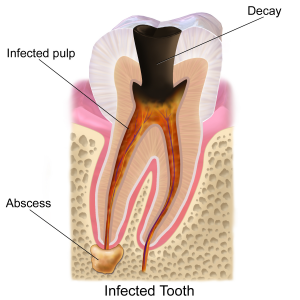There is a lot to know in the dental field. If you are looking to start a successful career in dentistry, then you should be looking for a school that cares about and drives your success.
Star of Texas Dental Assisting School is an Austin dental assisting school that extensively trains its students so that they are prepared for and knowledgeable about multiple aspects of dental assisting.
What do you know about cavities?
Decay
 If you were asked to describe a cavity, you would probably say the process was similar to rust – something that happens on the outside of the tooth that makes the tooth soft and creates a hole that would eventually be visible. You might even have the notion that bacteria are involved. And, you would be right in both cases.
If you were asked to describe a cavity, you would probably say the process was similar to rust – something that happens on the outside of the tooth that makes the tooth soft and creates a hole that would eventually be visible. You might even have the notion that bacteria are involved. And, you would be right in both cases.
The process of decay is a complicated interplay of an acidic and basic balance of chemistry in the mouth. Salivary flow and content, the presence of decay-causing bacteria, the age of the teeth, diet and the level of plaque all play a role in the decay (demineralization) as well as the rebuilding (remineralization) process involved in tooth decay.
Demineralization
At the very earliest stage of the decay process, there is not an actual “hole” in the tooth. There is, however, an alteration of the mineral content of the enamel. This stage of decay is completely invisible to the eye. It cannot be detected by an x-ray. It is a microscopic change where, due to the level of acid in the immediate area, the building blocks of enamel (calcium and phosphate) begin to dissolve on a microscopic level. When the acid environment is left unchecked (plaque is allowed to accumulate undisturbed against the tooth surface), more and more of the bonds between calcium and phosphate dissolve. This is a process called demineralization. If the acid challenge becomes severe and more of the underlying structure of the tooth begins to dissolve, the outer surface becomes unsupported. It is at this time that the actual hole, or what you call a cavity, appears.
Remineralization
When the outer surface of the enamel is still intact, with no break detectable, there is an opportunity for the bonds between calcium and phosphate to become re-linked through a process termed remineralization. And the great news is that dental science discovered that in the presence of fluoride, these bonds actually become stronger than they were initially. It is in this way that an early cavity can be reversed. When this happens, the tooth does not need to be drilled and filled.
The process of demineralization and remineralization can be seen as a tug of war on the molecular level of all surfaces of all your teeth, all the time!
How you Can Promote Remineralization
There are several steps you can take on a daily basis to help ensure that you are promoting remineralization. These are:
- Control your diet: watch the type of decay-promoting foods you eat and the quantity
- Improve your oral self-care by brushing and flossing daily
- Use topical fluoride on a daily basis
- Use antimicrobials and other anticaries agents as directed on a regular basis
- Maintain your dental hygiene recare schedule
The early stages of dental decay CAN be reversed with no loss of tooth structure, and you can help promote a healthy mouth by following just a few simple rules.
If you have any questions or want to get your foot in the door at the best dental assisting school in Austin, call Star of Texas today! (512) 487-1547

